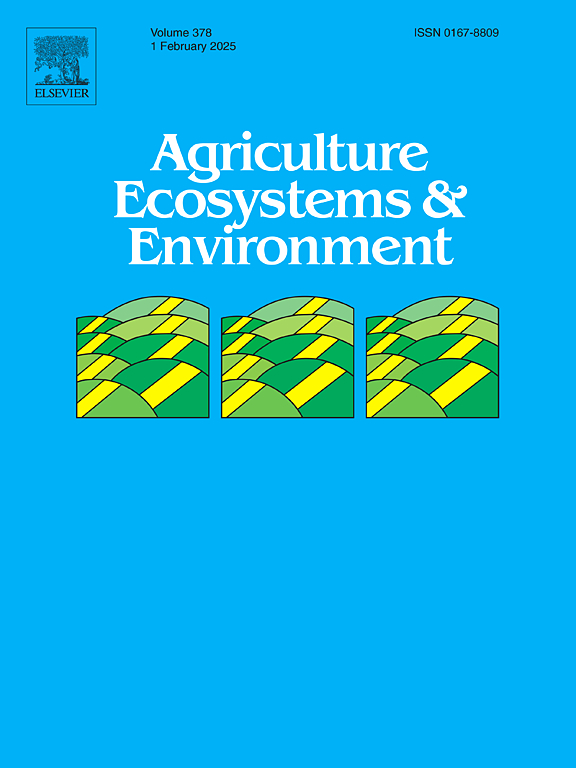玉米青贮和间种覆盖作物系统下高磷土壤的磷沥滤作用
IF 6
1区 农林科学
Q1 AGRICULTURE, MULTIDISCIPLINARY
引用次数: 0
摘要
在磷含量较高的农业生态系统中,管理好土壤中的磷对于在不影响产量的情况下减少水源中磷的流失至关重要。本研究旨在评估玉米青贮(Zea mays L.)+间种一年生黑麦草(Lolium multiforum)覆盖作物或使用接力覆盖作物和起始磷(P0、P10 和 P20)对(i) 磷沥滤,(ii) 土壤磷状况变化,(iii) 玉米产量、覆盖作物生物量和磷吸收的影响。2018 年至 2023 年期间,在两个地点进行了为期六年的研究。2021 年至 2023 年期间,每两周收集一次沥滤液样本。在 2021 年和 2022 年期间,与接力覆盖作物系统相比,间作覆盖作物系统中的钾浓度较高,8 月份达到 0.9 毫克/升,10 月份达到 1.45 毫克/升。与此相反,在接力覆盖作物下,渗滤液中的钾浓度在二月和三月较高,尤其是在 2023 年,这可能是由于覆盖作物在早春的建立和生长延迟所致。在种植青贮玉米后的前几周,使用阴离子交换膜(PO4AEMs)提取的钾浓度随着起始钾含量的增加而增加。在种植玉米后的第 4、第 7 和第 8 周,PO4AEMs 出现峰值,分别达到 1.18 和 1.73 µg cm-2 d-1,这与灌溉或降雨后土壤水分含量高有关。由于初始土壤磷含量较高,收获时干物质产量对起始磷缺乏反应。尽管累积磷预算为负值,但土壤磷状况仍然显著较高,平均为 196.6 毫克/千克-1(以 Mehlich-3 P 计)。通过仔细观察土壤钾指标之间的关系,可以发现与接力覆盖作物相比,间作土壤中的水提取钾呈快速下降趋势。可能是间播覆盖作物产生的高生物量增加了从土壤中吸收的钾量。我们的结论是,在高磷土壤中经济作物间套种覆盖作物可有效降低土壤中的磷含量,但由于土壤剖面的高水渗透率,可能会增加作物种植头几年的磷沥滤量。本文章由计算机程序翻译,如有差异,请以英文原文为准。
Phosphorus leaching in high-P soils under maize silage and interseeding cover crop system
Managing soil phosphorus (P) in agroecosystems with high P levels is crucial to mitigate P loss in water sources without compromising yields. The objective of this study was to assess maize silage (Zea mays L.) + interseeding cover crop of annual ryegrass (Lolium multiforum) or using a relay cover crop and starter P (P0, P10, and P20) on (i) P leaching, (ii) changes in soil P status, and (iii) maize yield, cover crop biomass and P uptake. A six-year study was conducted between 2018 and 2023 in two sites. Leachate samples were collected every two weeks between 2021and 2023. The concentration of P in leachate exceeded 0.5 mg L–1 indicating a high risk of P leaching at the current levels of soil P. High concentration of P in leachate with a peak at 0.9 mg L–1 in August and 1.45 mg L–1 in October during 2021 and 2022 was pronounced under interseeded compared to relay cover crop system due to improve water infiltration contributing to the downward movement of P. In contrast, the concentration of P in leachate was high under relay cover crops in February and March particularly in 2023, which could be attributed to the delay in cover crops establishment and growth in early spring. The concentration of P extracted using anion exchange membranes (PO4AEMs) increased with increasing starter P rate during the first weeks after planting maize silage. There were spikes of PO4AEMs, reaching 1.18 and 1.73 µg cm–2 d–1 during the 4th, 7th, and 8th weeks after planting maize which coincided with high soil moisture content occurring after irrigation or rainfall events. The lack of dry matter yield response to starter P at harvest was due to high initial soil P. The soil P status remained significantly high averaging 196.6 mg kg–1 as Mehlich-3 P, despite negative cumulative P budgets. A close observation of the relationships among soil P indicators shows a trend of rapidly decreasing water extractable P under interseeding compared with relay cover crops. It is possible that the production of high biomass under interseeding cover crops increased the amount of P taken up from the soil. We conclude that interseeding cover crops within cash crops in high P soils could be effective at decreasing soil P, but could enhance P leached in the first years of cropping due to high water infiltration along the soil profile.
求助全文
通过发布文献求助,成功后即可免费获取论文全文。
去求助
来源期刊

Agriculture, Ecosystems & Environment
环境科学-环境科学
CiteScore
11.70
自引率
9.10%
发文量
392
审稿时长
26 days
期刊介绍:
Agriculture, Ecosystems and Environment publishes scientific articles dealing with the interface between agroecosystems and the natural environment, specifically how agriculture influences the environment and how changes in that environment impact agroecosystems. Preference is given to papers from experimental and observational research at the field, system or landscape level, from studies that enhance our understanding of processes using data-based biophysical modelling, and papers that bridge scientific disciplines and integrate knowledge. All papers should be placed in an international or wide comparative context.
 求助内容:
求助内容: 应助结果提醒方式:
应助结果提醒方式:


